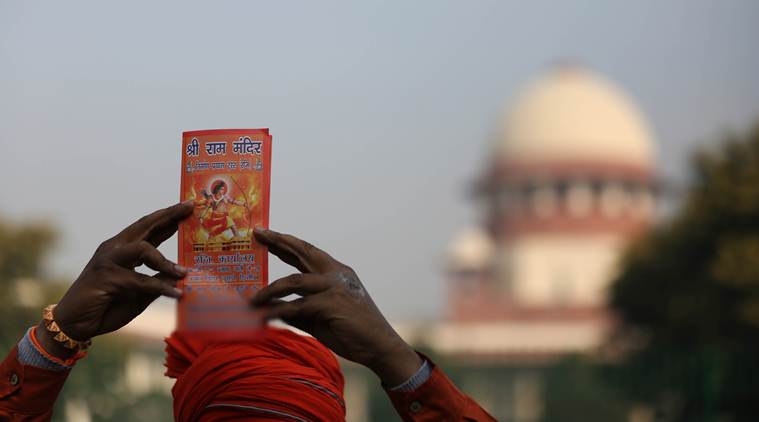 The Supreme Court bench, headed by Chief Justice of India Ranjan Gogoi, also comprises Justices S A Bobde, DY Chandrachud, Ashok Bhushan and S A Nazeer. (File)
The Supreme Court bench, headed by Chief Justice of India Ranjan Gogoi, also comprises Justices S A Bobde, DY Chandrachud, Ashok Bhushan and S A Nazeer. (File)
Ayodhya Ram Mandir-Babri Masjid Case HIGHLIGHTS: At the Supreme Court hearing on Ram Janmabhoomi-Babri Masjid land dispute case, one of the parties Nirmohi Akhara, told the bench Tuesday that Muslims have not been allowed to enter the disputed structure in Ayodhya since 1934 and sought control and management of the entire 2.77-acre land.
A five-judge constitution bench, earlier today, began hearing the Ayodhya land dispute case after mediation efforts failed last week. The bench is headed by Chief Justice of India Justice Ranjan Gogoi and includes Justices S A Bobde, DY Chandrachud, Ashok Bhushan and S A Nazeer.
Senior advocate Sushil Jain, appearing for Nirmohi Akhara, says “I am a registered body. My suit is basically for belongings, possession and management rights.” He further said, “We were in possession of inner courtyard and Ram Janmasthan for hundreds of years. Outer courtyard having ‘Sita Rasoi’, ‘Chabutra’, ‘Bhandar Grah’ were in our possession and it was never a part of dispute in any case.”
Explained | Where idea of ‘negotiation’ originated, how ‘mediation’ has always failed
Based on detailed conversations with the sides involved in the mediation, The Indian Express learnt that the side asking for a mosque submitted a proposal in a sealed envelope, during the committee’s second meeting in Faizabad, for a mosque and a temple adjacent to each other within the disputed area. It also gave a detailed layout for the same. But the proposal was a non-starter as it elicited no response from the side asking for the temple. Read | Four proposals saw some light till talks failed


 Mediation panel member Sri Sri Ravi Shankar in New Delhi on Thursday. (PTI)
Mediation panel member Sri Sri Ravi Shankar in New Delhi on Thursday. (PTI)

1. A five-judge Constitution bench headed by CJI Ranjan Gogoi begins the first day hearing of the Ayodhya dispute case. Senior Advocate Sushil Jain presents the case of Nirmohi Akhara while Advocate Rajeev Dhavan presented the case for a Muslim party.
2. Senior Advocate Sushil Jain, presenting the case of Nirmohi Akhara, tells the bench that Akhara's suit was basically for belongings, possession and management rights of the disputing.
3. He also tells the court that the Nirmohi Akhara was in possession of the inner courtyard and the Ram Janmasthan for hundreds of years and that no Muslims were allowed to enter structure since 1934.
4. The bench gets into a heated verbal exchange with senior advocate Rajeev Dhavan, who was appearing for a Muslim party. While Jain was speaking, Dhavan interfered and said perhaps there would not be any curtailment of arguments. The CJI said the hearing or the arguments would not be curtailed in any manner and there should be no doubt in anybody's mind about it.
The attempt at mediation and an amicable out-of-court settlement of the Ramjanmabhoomi-Babri Masjid dispute failed. The Supreme Court which has begun the day to day hearing from today against the verdict that the Allahabad High Court gave on September 30, 2010. The High Court had ordered that the disputed 2.77 acres of land in Ayodhya should be divided equally among the three parties, the Nirmohi Akhara sect, the Sunni Central Wakf Board Uttar Pradesh, and Ramlalla Virajman.
Subsequently, 14 appeals were filed in the Supreme Court against the High Court judgment. Read more
Advocate Sushil Jain, representing Nirmohi Akhara, tells the Supreme Court on the basis of Ahmedabad HC verdict that from 1934 to 1949, Muslims were offering Friday prayers at the disputed structure. To this, the SC replies that the HC verdict had noted that before 1934, Muslims were offering regular prayers at the disputed site.
Supreme Court tells Nirmohi Akahara that they have been given one-third of disputed area in preliminary decree by Allahabad High Court back in 2010. The Ahmedabad High Court's judgment, delivered in four civil suits, that the 2.77-acre land in Ayodhya be partitioned equally among the three parties -- the Sunni Waqf Board, the Nirmohi Akhara and Ram Lalla.
Supreme Court asks Nirmohi Akhara to confine its arguments to civil dispute case. Senior advocate Sushil Jain, appearing for Nirmohi Akhara, says that the Akhara was in possession of the inner courtyard and Ram Janmasthan for hundreds of years. He also tells the court that no Muslims were allowed to enter the structure since 1934 and it has been in exclusive possession of the Akhara.
Heated exchange between CJI Ranjan Gogoi and senior Advocate Rajeev Dhavan, who is representing the Mosque appellants in the case.
CJI: You will get your chance to reply. Do you have any doubts?
Dhavan: Your lordship asked me something. I gave the answer.
CJI: Please keep dignity of court. You are an officer of court.
Dhavan: Then don’t ask me such questions.
CJI: But there is a way to answer.
Dhavan: Well, this is my answer.
CJI: All we want to say is we won’t curtail anyone
Dhavan: I hope so.
Ayodhya hearing begins before five-judge Constitution bench headed by Chief Justice of India Ranjan Gogoi. Advocate Sushil Jain for Nirmohi Akhara opens arguments. He talks about the heritage of Nirmohi Akhara, saying that it was a very famous one. and the Rani of Jhansi was protected by the Nirmohi’s before she died in the Gwalior fort.